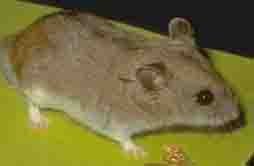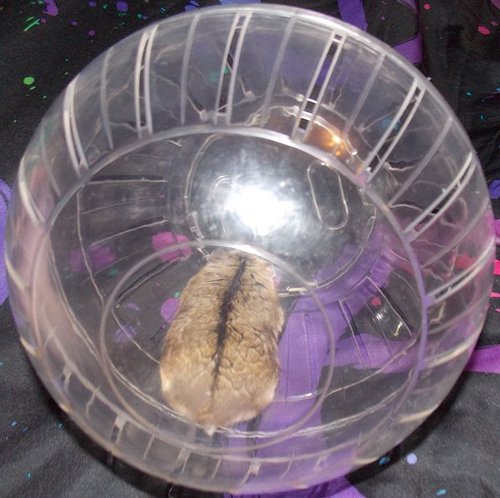When selecting a healthy dwarf hamster look for a pet that is:
Starting with a healthy pet is essential for dwarf hamster care.
Dwarf Hamster Care Facts:
- average dwarf hamster lifespan with active dwarf hamster care: 2 years to 3 years of age
- diet: herbivores (will eat mealworms)
- size: 2 to 4 inches long depending on the type
- can be kept in pairs of the same sex (opposite sex will breed)
- room temperature should not exceed 80F, avoid drafty areas, keep out of direct sunlight
- Grooms itself, can be cleaned with a damp washcloth or unscented baby wipes
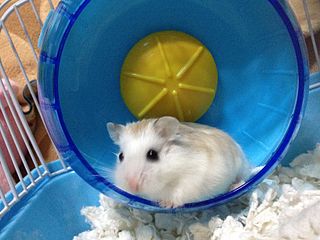 Roborovski Dwarf Hamster (Robo Dwarf Hamster)
Roborovski Dwarf Hamster (Robo Dwarf Hamster)
Dwarf Hamster Care Supplies
You'll need the following supplies for proper dwarf hamster care:
- 10 gallon or larger hamster cage
- food
- bedding
- food bowl
- exercise wheel
- hiding or nesting box
- hamster toys for play and exercise
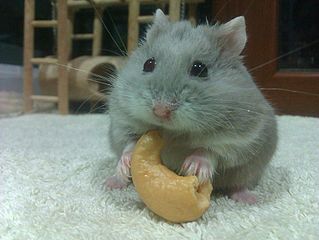 Campbell Dwarf Hamster
Campbell Dwarf Hamster
Dwarf Hamster Care and Food
A pelleted diet combined with fresh vegetable and fruit on occasion will provide your dwarf hamster with a balanced diet. Try to match the amount of food left in the cage to the amount consumed each day. Do not limit the diet to just seeds, as these are high in fat and could lead to obesity.
Old food should be removed from the cage daily. The food dish should be cleaned daily as well for hygienic dwarf hamster care.
Safe Dwarf Hamster Foods:
- Yogurt
- White bread
- Tomatoes (not the green part)
- Sunflower seeds
- Berries (strawberries, raspberries, blueberries)
- Grapes
- Boiled Rice, Cooked Pasta, Cooked Meat, Cooked Fish, Cooked Chicken, Cooked Eggs
- Meal worms
- Meadow Hay
- Iceberg Lettuce
- Cottage Cheese
- Corn on the Cob
- Cauliflower
- Carrots
- Bananas
- Apples
Dwarf Hamster Cages
Dwarf hamsters require a minimum of a 10-gallon aquarium size dwelling. A glass aquarium or plastic rodent cage can be used as a hamster habitat. Aquarium style habitats are popular for dwarf hamsters since the pet's small size sometimes makes it possible to slip through widely spaced wire cages. Hamsters prefer to have separate areas for eating, sleeping and for going to the bathroom. All hamster tubes and hamster toys should be cleaned weekly with a mild detergent.
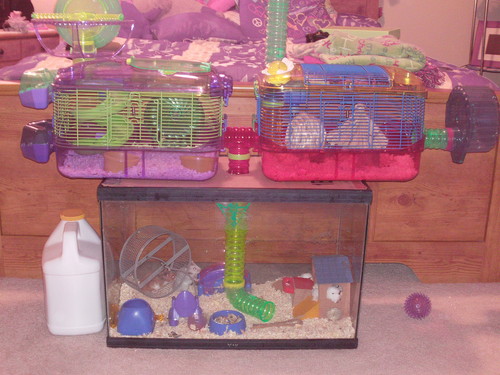 This Hamster Cage Includes a Traditional Aquarium and Two Wire Cages from Super Pet Critter Trail
This Hamster Cage Includes a Traditional Aquarium and Two Wire Cages from Super Pet Critter Trail
Shown: Super Pet Crittertrail Extreme Challenge Habitat
Absorbent pelleted bedding, shredded paper, or certain types of wood shavings can be used as bedding. Remember never to use pine or cedar shavings, as the fumes emitted from them can cause respiratory disease in both you and your pet. The soiled bedding should be removed daily, and the cage completely cleaned out and washed every week. Feed your dwarf hamster a commercial ‘hamster mix’ from the pet store, and supplement with occasional fresh vegetables, wooden chew toys, and paper towels for the hamster to shred up as bedding. Provide 1 to 2 inches of bedding in cage.
Water should be provided via a bottle that is cleaned and filled daily. Avoid using a water dish since hamsters will wade in and pollute the water.
One dwarf hamster care tip is to purchase a holding or travel cage for when cleaning the hamsters habitat. Another approach is to purchase a hamster toy such as hamster ball which provides exercise and services as a quick cage solution.
Shown: Hamster Ball from Amazon
Housing More Than One Dwarf Hamster
Unlike the Syrian hamster, which are strictly solitary and should never be housed together due to their tendency to fight aggressively, dwarf hamsters can sometimes be housed together. Roommates should be of the same sex, and should be monitored carefully to be sure that they get along, especially during the introductory period.
Dwarf Hamster Babies and Breeding
Males and females should never occupy the same dwelling, as they are very quick and efficient breeders. While it may sound like fun or like a ‘learning experience’ to breed your hamsters, hamster owners who try this are more often than not overwhelmed with pups they cannot find homes for. With an average litter of 2-5 pups, and a gestation period of only about 20 days, it’s easy to see how your pet hamster population can explode within a matter of months.
Hamsters and Children
Hamsters are not appropriate pets for small children. This is true for the dwarf species, even more so than for the Syrian hamster. The dwarf hamster species are very tiny making them especially fast and difficult to handle, a dwarf hamster care challenge. They are also much more fragile and easily injured. A child who accidentally squeezes the animal too hard or drops him can easily cause fatal injuries. This is traumatic not only to the poor hamster, but also to the child. Children of any age should always be supervised when handling dwarf hamsters and other ‘pocket pets’.
When you first bring a hamster own, introduce yourself with a calm voice. Once your hamster stays calm when you are present, he or she is ready for gentle handling. At first, don't pick up the hamster, but leave the your hand in the cage to make it seem familiar to the pet. Over time, she will get used to the hand and welcome your presence. Before picking up the hamster, place a treat in your palm. Let the hamster get the treat without picking it up. Go slow and once the hamster shows familiarity then advance to the next step. It can take a few days until the hamster is ready. When lifting the hamster out of the cage in the cup of your hand, use the other hand on top to avoid dropping the hamster or allowing him or her to leap out and potentially get injured.
If you have trouble handling the hamster, try putting a treat in a bowl or large cup and lure the hamster into it with a treat, Then lift the cup.
Dwarf Hamster Care Health and Diseases
As mammals, dwarf hamsters are susceptible to many of the same diseases as other pets such as hamster colds, food allergies, but also have some that are unique to these pets. Any signs of illness that last for two days or longer should be brought to the attention of a veterinarian. If you aren't sure, we suggest using this online veterinary service that has Vets available 24 hours a day that will answer questions for a very small fee.
Look for signs of illness such as:
- Poor appetite
- Lethargic, non-energetic behavior
- Swollen stomach
- Constant Scratching
- Bad Odor
- Discharge from Ears and nose
If you see any of these signs, then you should see your Veterinarian as soon as possible:
- Ear infections cause hamsters to circle
- Eye Discharge
- Diarrhea: Note that diarrhea can be caused by an over feeding of green vegetables
- Wet rear end (condition called Wet Tail)
- Excessive Drinking and Urinating: Frequent urination can indicate diabetes
- Skin Problems such as Bumps: Indicates an abscess or tumor. May require surgical removal
If you see a hamster bleeding then it could indicate cancer. Rectal (from the rear) bleeding indicates either er a tumor, cancer, or intestinal issues. Bleeding from other locations can be due to injury, of if you have two hamsters living together, a bite. The rule of thumb is that if you see blood you should visit the Veterinarian. Many will provide discounts for hamsters since the high cost keeps many owners from seeking the appropriate health care.
Hamster Colds
Hamster colds have symptoms such as a watery eyes or runny nose. Also they may act lethargic or show signs of breathing difficulty. If this is the case, see a Vet. You can place the hamster cage in a warmer area. Provide new bedding.
Hamster Constipation
If you see the pet hamster having problems such as lethargic behavior or back arching, the problem might be constipation. Other signs include a reluctance to be held. In this case, try providing a few drops of olive oil. After treatment increase fruit consumption and exercise. Greens that are sprayed with water will help to rehydrate your pet.
Hamster Hair Loss
Hair loss in hamsters could be due to rubbing against rough surfaces in the cage or it could indicate a health problem such as parasites (demodex mites). Skin scratching can also indicate a parasite problem. Must be differentiated from other conditions such as adrenal disease, dietary problems, liver disease and fungal infection.
Hamster Tooth Problems
Hamsters gnaw and chew to keep their teeth trimmed. If the diet isn't properly balanced, it could result in dental problems.
Signs of Hamster Dental Problems (called Hamster malocclusion):
- Appetite loss
- Odor from Mouth
- Drooling
- Respiratory problems
- Overgrown teeth
To correct dental issues, a change in diet or a Vet may need to manually trim the teeth.
For more information, download this brochure on dwarf hamster care (PDF Download)
Have a Pet Question for our Vet? We'll Answer it for Free!
Would you like to ask our Veterinarian a question? Just ask and we'll get back at you with an answer from our Vet for free!
If you need an immediate response, we suggest trying this online veterinary service that is available now to answer your questions.
